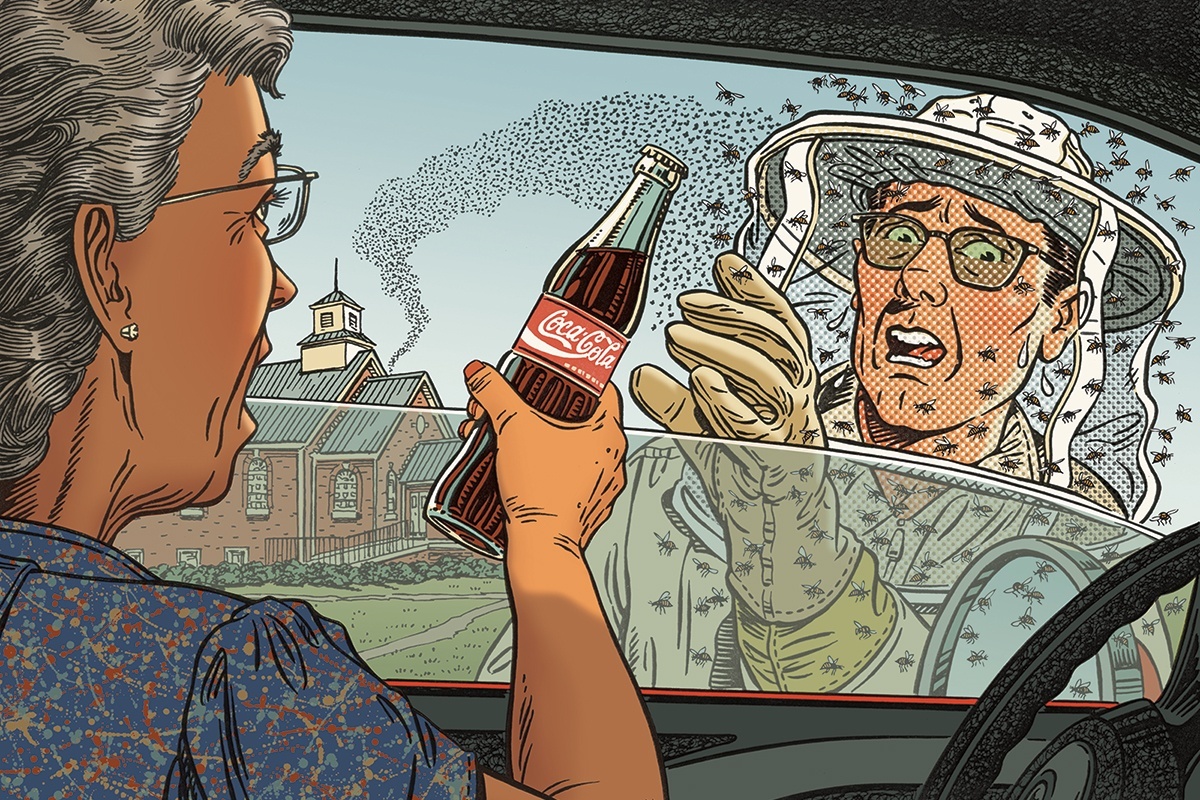As president of the association that cares for Historic Eagle Springs Baptist Church, the last remaining building in the almost-vanished town of Eagle Springs in Coryell County, I shuddered when I got the news.
Richard Newman, the young man who mows our spiky weeds (not even the most optimistic among us would call it a lawn), had encountered a hive of angry bees living in the church attic and been stung 20 or 30 times and was on his way to the emergency room.
We learned the hard way that bees and internal combustion engines are mortal enemies, and the bees’ wrath extends to the humans that operate the hated machines. Richard’s gas-powered weed trimmer triggered the venomous attack, and although he hightailed it for home about a half-mile away, the unforgiving bees chased him right to the front door.
After we confirmed Richard’s recovery, I called an emergency meeting of the association—but not at the church, which was still off-limits because of the bee uprising. Our annual homecoming celebration, the fundraiser that enables us to pay the electric bills and keep up with the constant repairs required for the 140-year-old building, was a mere two weeks away.
We decided to hire a local company that relocates unwanted swarms by vacuuming them out of the wall along with their honey. This simple plan had a fatal flaw created by a rare rainy spell: The vacuum (or maybe the employees) didn’t work in the rain.
On to plan B: David Scott, our vice president, located a beekeeper in nearby Gatesville. “Yes,” he said. “I’ll relocate the bees and the honey.” If the honey re-mained inside the wall, he explained, wild bees would move in and we’d be right back where we started. He explained that he would need to cut a hole in the ceiling to gain access to the hive.
On the designated day, the phone rang. “The beehive in the attic of the church is huge, the biggest I’ve ever seen, and this job is taking longer than I thought,” the beekeeper said. “I’m diabetic, and my blood sugar is getting too low. Could you bring me a Coke?” I exceeded the speed limit covering the 2 miles from my house to the church, haunted by visions of an unconscious beekeeper lying on the ground. When I arrived, the beekeeper, dressed in his protective suit, was barely visible inside a vortex of angry bees. I lowered the window just enough to hand him the Coke.
“These are Africanized bees,” he said through my closed window. “I’m not going to try to relocate them.” He showed me an astonishing photo on his honey-encrusted phone of what looked like large snakes hanging down from the peak of the roof, pointing out the tiny octagonal cells of the honeycomb.
Africanized honeybees, which look just like their better-behaved cousins, European honeybees, have colonized Texas since their arrival from Brazil in 1990. Their impulse to sting is 10 times greater, and attacks last longer. Once disturbed, they remain aggressive for as long as 24 hours. A swarm of Africanized honeybees attacked and killed a 62-year-old man one county over in 2013, so the beekeeper’s decision to eradicate them met no resistance from us.
Our carpenter repaired the ceiling a few days later and patched the bee-sized cracks in cypress siding that had been hauled by ox wagon from Galveston in 1878. David and I swept up a snowdrift of dead bees inside the church and wiped up honey that had dripped from the ceiling onto the floor below.
When homecoming arrived, we had the church to ourselves again, but no one rejoiced at the outcome. Bee populations in Texas are in a steep decline, and rural Texans recognize the importance of bees to agriculture. “USDA researchers are hard at work to determine the cause of a problem called colony collapse disorder, which is wreaking havoc with the beekeeping industry,” says Blake Shook of Blue Ridge, a Fannin County Electric Cooperative member who is on the executive board of the American Beekeeping Federation. “The disorder appears to be a combination of several factors: stress, pesticides, lack of good forage and new diseases. When European bees die out, it’s possible for Africanized bees to get a foothold, at least in the parts of Texas where Africanized bees thrive. They don’t do well in North Texas, where winters are cold.”
I’ve often thought that if the walls of the Historic Eagle Springs Baptist Church could talk, they’d have some astounding tales to tell. Historic accounts relate that in early days, the men of the congregation attended services with rifles across their knees for security. Horse thieves chased one early pastor into the brush for preaching against such unlawful activities. Our great bee invasion adds another chapter to the old building’s rich history.
Martha Deeringer, a member of Heart of Texas EC, lives near McGregor.


